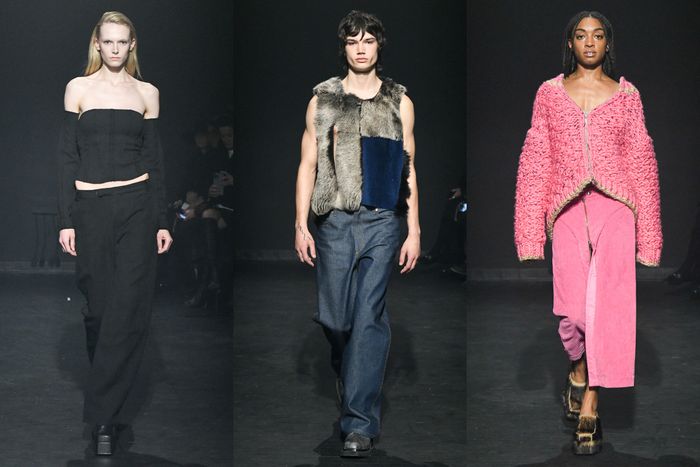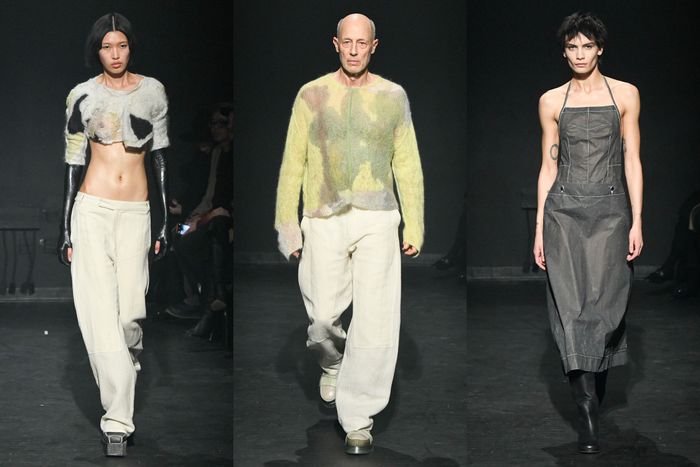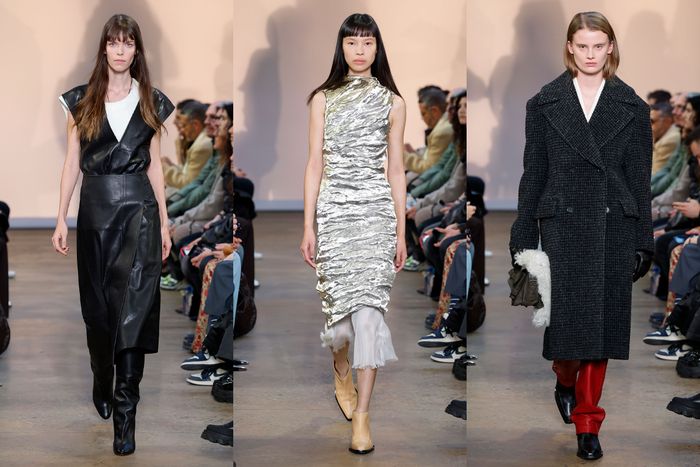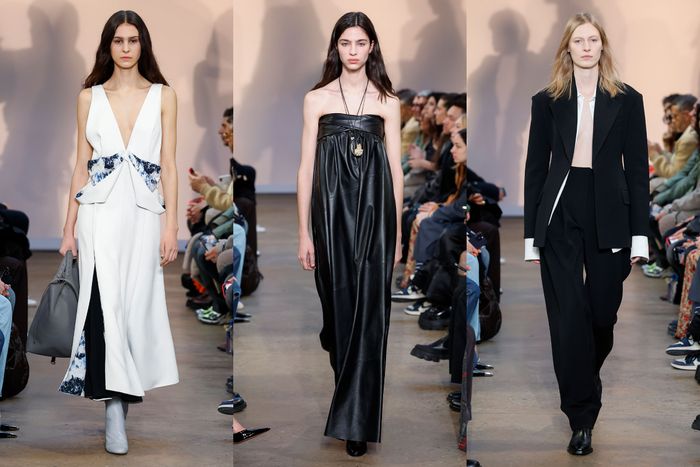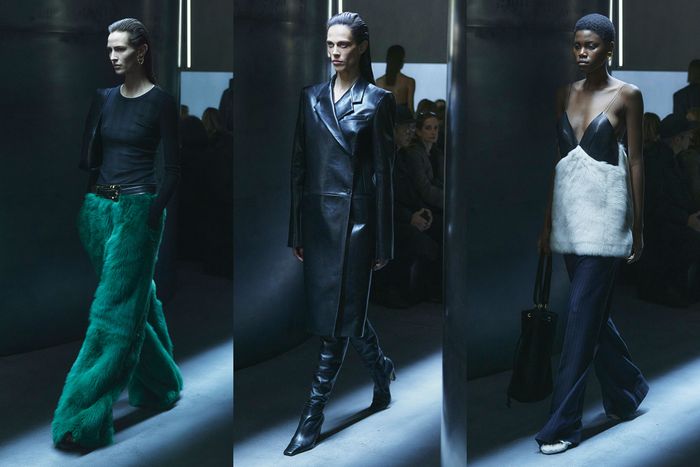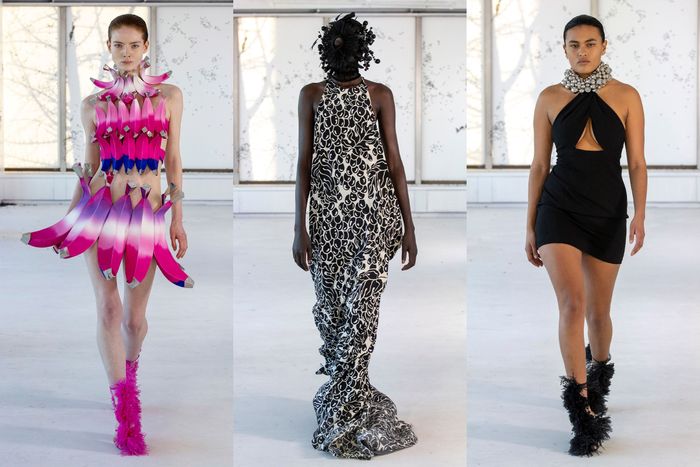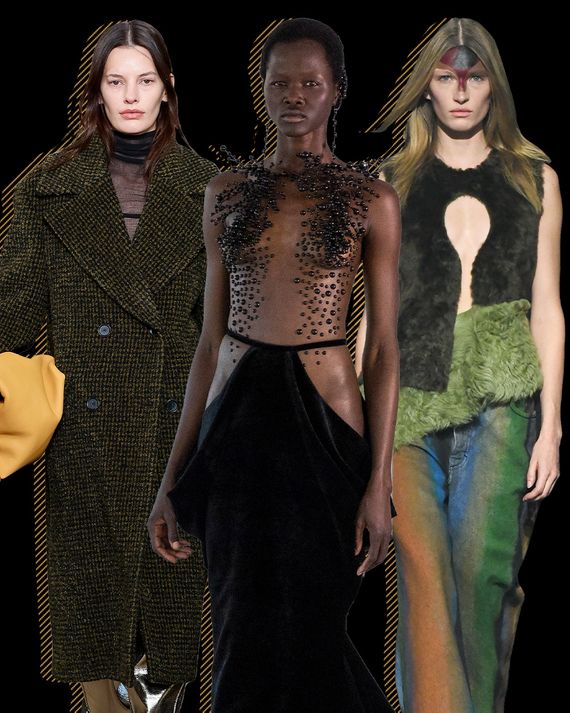
I thought often of Helmut Lang while watching two of the better shows over the weekend, Proenza Schouler and Eckhaus Latta. At the Chelsea Factory, Jack McCollough and Lazaro Hernandez of Proenza arranged their seats in a labyrinth, requiring the models to snake around the room but also bringing the audience closer to them. That’s an old Lang setup from his days in Paris. And they featured classic masculine coats over plain sweaters and silver or gold metallic jeans, another bit of Lang déjà vu, and opened the show with their friend Chloë Sevigny.
Later, I looked up the well-known New Yorker profile of Sevigny from 1994, when she was 19, and was not surprised that she called Lang her favorite designer. That was the year the Austrian minimalist showed his fetishistic rubber dress — actually a Chantilly lace shift glued to a thin layer of latex — and black suits with red-and-silver-gray nylon T-shirts that crinkled like candy wrappers. The other night in the East Village, Mike Eckhaus and Zoe Latta opened their show with a male model in a black wool coat with a dark cropped sweater and pants, followed by cavemen-style vests in shearling with jeans and pieces in wax-coated nylon and laminated organza. Lang, who in the ’90s once showed sleeveless tops in a brown furry material, was famous for creating a sexual tension that was hard to pinpoint. The same has been said in recent years of Eckhaus Latta.
Obviously many designers owe a debt to Lang, who retired from fashion in 2005. When he created the rubber dress, it was to offer a new kind of glamour — away from the bombastic variety of Mugler and Gaultier and the bourgeois refinement of Saint Laurent. One of the first designers to present men’s and women’s fashion together, and to include friends who weren’t models, like the artist Elfie Semotan, Lang had a knack for making his clothes hover between the everyday — mainly through tailoring — and the erotic. Today, thanks to wider and freer notions of gender and sexuality, not to mention improved techniques and the advent of social media, designers have evolved those ideas for a new generation that has utterly different beliefs about the body.
Latta and Eckhaus have been in that vanguard, often using knits as their medium. This season they were slit, or severely cropped and partially unfinished and exposing a breast, or a blotchy composite of muted color, as with the green pullover on the actor Jon Gries, who caused a mild stir when he came out— “Look, Greg from White Lotus!” (As Zoe Latta admitted, “Celebrity models are not really our deal. He’s a friend’s boyfriend and he asked us if he could do the show.”)
What struck me most about the collection was its harder, more direct sexiness. The telling looks were the guy with chiseled features in the opening black overcoat, followed by a girl in a black bustier and boyish linen trousers riding low on her skinny frame. But also: the shearling vests with wide-legged jeans, including one pair in hand-painted stripes; an iodine-colored top and skirt in laminated organza that showed the body underneath; and an austere apron dress in cement gray made of wax-coated nylon. Eckhaus characterized the sexy difference as “more confident.” Either way, it ushers in a fresh change at the label.
The Proenza designers called their collection their most personal yet. Which might seem a strange thing to say, given that Hernandez and McCollough have been in business for two decades. But they haven’t always stuck to a clear path. Last season, for instance, they showed bubble skirts and fiesta sleeves. “Not us,” as Hernandez conceded. This time, they tried a different approach. Instead of designing whole outfits, they focused on individual pieces based on the lifestyles and tastes of women they know, many of whom are now older and have families. In addition to Sevigny, they invited Olympia Scarry and Meghan Collison, a former Proenza model, to walk. Collison wore a black leather wrap dress over a white sweater, Scarry a white suit with matching boots.
In a way, though, the star of this adult vision was the chameleon model Julia Nobis, who appeared twice — first in a black trouser suit, probably the defining statement of the collection, with a white crinkled silk blouse with French cuffs left undone, and, at the end of the show, in the same jacket and shirt but now with a black boucle mid-length skirt with deep vents. The pantsuits and the coats were chic, almost nothing — that is, not overdesigned. Also strong were the sweaters, which look wonky when laid flat on a table but are designed to twist a bit around the body, and the long and flared V-neck dresses in black or white with soft panels of a silk print that were upcycled from a past Proenza Schouler collection.
You have to wonder, in a post-Lang world, what the new language of dress and glamour is, and who has the authority. It is certainly not the stilted, overly stylized expression of Khaite on Sunday night in Soho, with models in straight-line skirts, shag-fur maxi coats and shag-covered pumps and sandals (after Phoebe Philo at Céline), and big capes walking at a silly tortoise pace. The designer, Catherine Holstein, is great at doing leather and trim-looking nylon blouson jackets with skirts, but the collection suffered from too-muchness, and a lot of her tailoring — which veered from classic to oversize and slightly hourglass — was not as precise as this stuff needs to be.
In an original and funny show the other day at the United Nations, Piotrek Panszczyk of Area proved a fundamental point about fashion and art. It can come from what’s around us — just as the Warhol soup can or indeed his peel-off banana on the cover of the 1967 “Velvet Underground & Nico” album did. Panszczyk’s entire collection was based on fruit — bananas and watermelon — and the notion of freshness and decay, with an accompanying soundtrack of buzzing flies. “Fruit seems so mundane, but actually when you look at it culturally it’s quite provocative,” he said.
He delivered with artfully constructed dresses based on bunches of bananas, skimpy beaded tops and miniskirts that evoked the fruit’s smiling curve, and some magical and near-naked black gowns and bodysuits with clusters of tiny black feather or wired beads that suggested, in his fruit-and-decay context, a swarm of flies — but which in real life would just look amazing.
The reference to Josephine Baker’s banana costume in 1920s Paris was no accident. I brought up the fact that Dior, in January, had referenced Baker but had avoided her most famous garment, perhaps out of concern of offending someone. Panszczyk shrugged and said, “They didn’t go there.” Of his own approach, he said, “For me, it’s honesty. And cultural things that connect to each other can also break down certain stereotypes.”
More From New York Fashion Week
- The Best Street Style From New York and Milan Fashion Weeks
- Aoki Lee Simmons Is Just Getting Started
- Where to Buy New York Fashion Week Street-Style Looks



